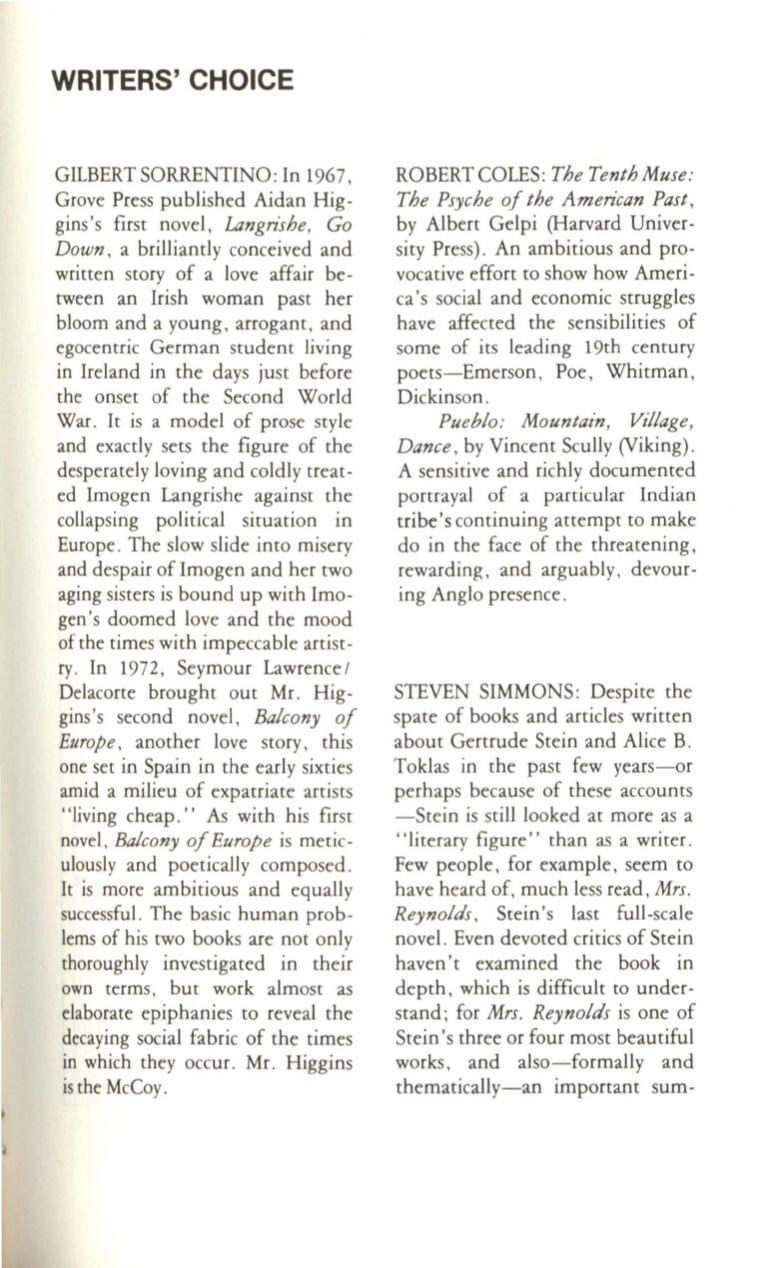
WRITERS' CHOICE
GILBERT SORRENTINO : In 1967 ,
Grove Press published Aidan Hig–
gins's first novel,
Langnshe, Go
Down ,
a brilliantly conceived and
written story of a love affair be–
tween an Irish woman past her
bloom and a young , arrogant , and
egocentric German student living
in Ireland in the days just before
the onset of the Second World
War. It is a model of prose style
and exactly sets the figure of the
desperately loving and coldly treat–
ed Imogen Langrishe against the
collapsing political situation in
Europe . The slow slide into misery
and despair of Imogen and her two
aging sisters is bound up with Imo–
gen's doomed love and the mood
of the times with impeccable artist–
ry . In 1972 , Seymour Lawrence!
Delacorte brought out Mr. Hig–
gins 's second novel ,
Balcony of
Europe,
another love story , this
one set in Spain in the early sixties
amid a milieu of expatriate artists
"living cheap ." As with his first
novel,
Balcony ofEurope
is metic–
ulously and poetically composed.
It is more ambitious and equally
successful. The basic human prob–
lems of his two books are not only
thoroughly investigated in their
own terms , but work almost as
elaborate epiphanies to reveal the
decaying social fabric of the times
in which they occur . Mr . Higgins
is the McCoy.
ROBERT COLES :
The Tenth Muse :
The Psyche of the Amen'can Past ,
by Albert Gelpi (Harvard Univer–
sity Press) . An ambitious and pro–
vocative effort to show how Ameri–
ca 's social and economic struggles
have affected the sensibilities of
some of its leading 19th century
poets- Emerson, Poe, Whitman ,
Dickinson .
Pueblo: Mountain , Vtflage,
Dance ,
by Vincent Scully (Viking) .
A sensitive and richly documented
portrayal of a particular Indian
tribe's continuing attempt to make
do in the face of the threatening ,
rewarding , and arguably, devour–
ing Anglo presence.
STEVEN SIMMONS : Despite the
spate of books and articles written
about Gertrude Stein and Alice B.
Toklas in the past few years-or
perhaps because of these accounts
- Stein is still looked at more as a
" literary figure" than as a writer.
Few people, for example, seem to
have heard of, much less read,
Mrs.
Reynolds ,
Stein 's last full-scale
novel. Even devoted critics of Stein
haven't examined the book in
depth , which is difficult to under–
stand ; for
Mrs. Reynolds
is one of
Stein's three or four most beautiful
works , and also-formally and
thematically-an important sum-


